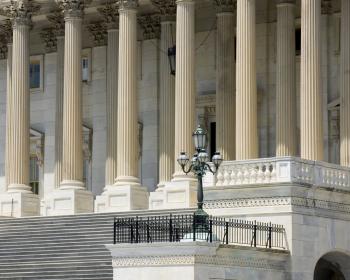An Overview of the 3rd Amendment
 Third Amendment: The Quartering of Soldiers
Third Amendment: The Quartering of Soldiers
What is the Third Amendment?
No Soldier shall, in time of peace be quartered in any house, without the consent of the Owner, nor in time of war, but in a manner to be prescribed by law.
The Third Amendment Defined:
The Third Amendment is a part of the Bill of Rights, which are the first 10 Amendments to the United States Constitution and the framework to elucidate upon the freedoms of the individual. The Bill of Rights were proposed and sent to the states by the first session of the First Congress. They were later ratified on December 15, 1791. The Third Amendment was introduced on September 5, 1789.
The first 10 Amendments to the United States Constitution were introduced by James Madison as a series of legislative articles and came into effect as Constitutional Amendments following the process of ratification by three-fourths of the States on December 15, 1791.
Stipulations of the 3rd Amendment:
The Third Amendment prohibits, during times of peace, the quartering of soldiers on private property and in private homes without the consent of the owner. The Third Amendment makes the quartering of soldiers permissible only in times of conflict or war and then only according to the area’s particular laws.
The Third Amendment is routinely regarded as one of the least cited sections of the United States Constitution. The reasoning behind this notion or lack of use stems from the obsolete nature of the passage—rarely in modern times are soldiers quartered in private homes. That being said, the Amendment is occasionally cited as a base for the right to privacy.
How was the 3rd Amendment Created?
The original constitution was met with skepticism due to the lack of civil liberties. In response, the bill of Rights was created to include the 3rd Amendment along with the rest of the Bill of Rights. Numerous revisions were drafted to better elucidate upon the distinction between times of war and times of peace and whether the executive or the legislative branch of government would possess the power to authorize quartering.
Court Cases tied into the 3rd Amendment
In Youngstown Sheet & Tube Co. v. Sawyer, the court ruled that the framers of the Constitution intended to constrain executive power even during times of war. The court ruled that military powers of the executive branch were not meant to supersede representative government of internal affairs.
State Timeline for Ratification of the Bill of Rights
New Jersey:November 20, 1789; rejected article II
Maryland:December 19, 1789; approved all
North Carolina:December 22, 1789; approved all
South Carolina: January 19, 1790; approved all
New Hampshire: January 25, 1790; rejected article II
Delaware: January 28, 1790; rejected article I
New York: February 27, 1790; rejected article II
Pennsylvania: March 10, 1790; rejected article II
Rhode Island: June 7, 1790; rejected article II
Vermont: November 3, 1791; approved all
Virginia: December 15, 1791; approved all
Related Topics
- Jones Act Text
- An Overview of the 10th Amendment
- An Overview of the 26th Amendment
- Gouverneur Morris
- A Background to the Constitutional Convention
- Supreme Courts Criticisms Overview
- TEXT of the Neutrality Act of 1937
- Article 1 Overview
- The Basis of Constitutional Law Overview
- An Overview of the 18th Amendment